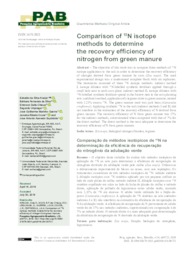Comparison of 15N isotope methods to determine the recovery efficiency of nitrogen from green manure.
Comparison of 15N isotope methods to determine the recovery efficiency of nitrogen from green manure.
Author(s): ARAUJO, E. da S.; SILVA, B. F. da; DALLA CHIEZA, E.; URQUIAGA, S.; GUERRA, J. G. M.; ROUWS, J. R. C.; ESPINDOLA, J. A. A.
Summary: The objective of this work was to compare three methods of 15N isotope application to the soil in order to determine the recovery efficiency of nitrogen derived from green manure by corn (Zea mays). The used experimental design was a randomized complete block with six replicates. The treatments consisted of three 15N isotope methods: indirect method I, isotope dilution with 15N-labelled synthetic fertilizer applied through a small hole next to each corn plant; indirect method II, isotope dilution with 15N-labelled synthetic fertilizer spread in the furrow next to the corn planting row; and direct method, application of a legume straw as green manure, treated with 2.23% excess 15N. The green manure used was jack bean (Canavalia ensiformis). Applying synthetic 15N to the soil (indirect methods I and II) did not interfere in the estimation of the recovery efficiency of N derived from green manure. The recovery efficiency of N from green manure was 17% for the indirect methods, overestimated when compared with that of 7% for the direct method. The direct method is the most adequate to determine the recovery efficiency of N from green manure.
Publication year: 2019
Types of publication: Journal article
Unit: Embrapa Agrobiology
Observation
Some of Embrapa's publications are published as ePub files. To read them, use or download one of the following free software options to your computer or mobile device. Android: Google Play Books; IOS: iBooks; Windows and Linux: Calibre.
Access other publications
Access the Agricultural Research Database (BDPA) to consult Embrapa's full library collection and records.
Visit Embrapa Bookstore to purchase books and other publications sold by Embrapa.

